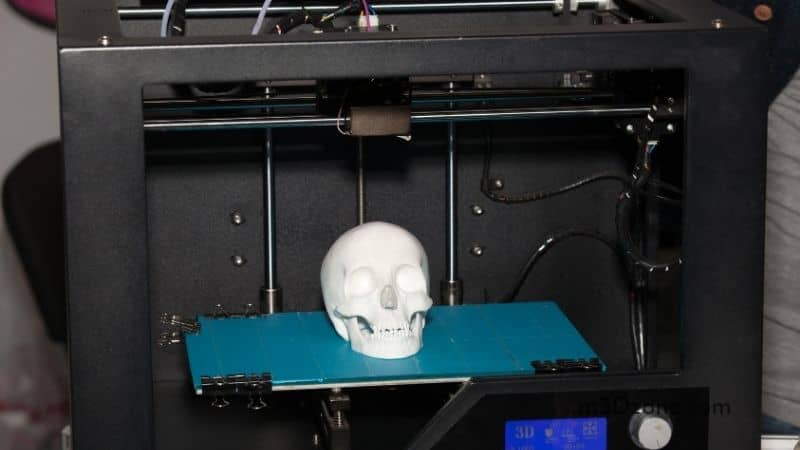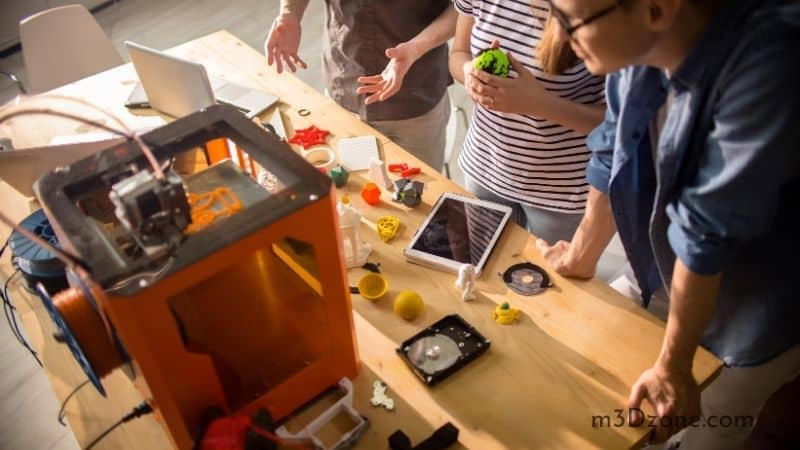Are you concerned about fumes and smells emitted by 3D printers during an operation? Are you worried that they could be hazardous to your health?

Yes, 3D printing smells. The stench is produced since 3D printers use heating technology to melt filament materials. Most 3D printing materials come from different types of plastics. Inevitably, burning plastic causes an odor that is harmful to your health.
To mitigate the 3D printing smell, you need to ensure the room is well-ventilated. Also, you need to follow recommended 3D printing precautions strictly.
Quick Navigation
- Are 3D Printer Fumes Harmful?
- Does 3D Printing Produce Fumes?
- Is It Safe to Have a 3D Printer in Your Room?
- Does PLA Smell Bad?
- Does 3D Printer Filament Smell?
- Do Resin 3D Printers Smell?
- Is 3D Printing Filament Toxic?
- What Precautions Should Be Taken When 3D Printing?
- Different 3D Printing Smells
- Conclusion
We have provided a guide that has all the information you need. Without further ado, let’s dive in.
Are 3D Printer Fumes Harmful?
If your main concern is whether inhaling 3D printer fumes is harmful to your health. First, you need to know that 3D printers use different filament materials, but the most common are ABS and PLA.
Studies show that PLA filament is safe for use. On the contrary, ABS filament is not safe. Therefore, you need to make sure you conduct your operations in a spacious environment.
Related: Is 3D Printed PLA Food Safe?
ABS Plastic Fumes
ABS emits toxic chemicals when subjected to extreme heat. Fumes that are produced by ABS filaments contain toxic chemicals known as styrene. In consequence, if inhaled in high volumes, styrene causes headaches, fatigue, and a feeling of drowsiness.
Does 3D Printing Produce Fumes?
Yes, the 3D printing process produces fumes. PLA and ABS filaments emit fumes as these plastic filaments are burnt and melted under high temperatures. The longer the printer is left to run, the higher the volume of fumes released into the air.
Depending on the 3D model, the printer may run overnight, producing huge volumes of fumes that are not safe to breathe.
Is It Safe to Have a 3D Printer in Your Room?
Where is the ideal place to put your 3D printer? What about placing it in your room? Is it safe?

These questions could sum up what runs in your mind when you want to invest in a 3D printer. The answer is that your room may not be the best place to put your printer. However, if you have to put it there, ensure you take necessary precautions as enumerated below.
-
Temperature and Humidity
Is your room humid? If so, you ought to be worried because 3D printing works poorly in humid conditions. High humidity ruins your filament as it soaks up moisture, making it brittle and breakable. Make sure to use dehumidifiers as they help to lower the humidity levels of your filaments.
-
Sunlight
Sunlight provides an opposite effect compared to humidity. It causes filaments to overdry, and the impact is the production of poor-quality 3D printed models.
Sunlight makes the end product brittle and breakable.
-
Drafts
Drafts and vibrations from movements lower the final quality of printed objects. Ensure the room you’re carrying out these operations doesn’t cause physical disturbances.
It is ideal to place your 3D printer in an area that will deliver high-quality 3D printed products. Therefore, don’t put your 3D printer in places where people pass all the time to avoid the commotion.
Does PLA Smell Bad?
No, PLA doesn’t smell bad. On the contrary, it produces a bearable smell.
PLA filament is an organic substance made from vegetables and corn starch. So, it exudes sweet smells like honey during the 3D printing process. Its aroma is irresistible.
Does 3D Printer Filament Smell?
The 3D printer doesn’t smell. The 3D printer filament material is what emits a harsh smell.
The heating technology is central to 3D printer filaments, emitting fumes that smell. Although ABS may be safe when 3D objects are printed in a well-ventilated environment, it is not safe when it’s being heated and melted into molten.
The higher the heating temperature, the more your 3D printer’s filament will emit a smell because of the large volumes of fumes produced.
Do Resin 3D Printers Smell?
Yes, they do! Stereolithography is a type of additive manufacturing process that uses UV rays to print 3D models and objects. Concentrated ultraviolet light is directed at the resin to link molecular particles, layer by layer, forming a 3D printed object.
Resin is the liquid that binds the layers together and fastens the cooling process of the heated plastic filaments.
The resin may have a strong smell or a subtle one depending on its type in liquid form.
Avoid exposing your skin to liquid chemicals of 3D printing resin. The chemicals smell foul and can cause a skin rash. If exposed to resin for a long period, this skin rash could turn into an allergy.
Resin is harmful as it gives out chemical fumes. Therefore, you need to work in a well-ventilated room or deploy an air purifier system. Alternatively, you may use a carbon filter to guarantee health safety.
Is 3D Printing Filament Toxic?
Yes, it is! As a person interested in 3D printer technology, you need to know the 3D printing filaments safety before you buy one. 3D printer filaments exude toxic particles throughout the 3D printing process.
If you don’t control the printer’s running time, it can emit high volumes of toxic fumes. While PLA is a non-toxic, biodegradable, and user-friendly plastic filament, ABS filament materials produce fumes that are harmful.
In mitigation, the use of air extractors is recommended. The control of toxic 3D filaments helps you avoid health risks.
The 3D printers that use inkjet technology produce toxic chemical gases. For Health purposes, it is critical to protect the human skin from these toxic chemicals. Avoid any form of contact with these dangerous fumes.
What Precautions Should Be Taken When 3D Printing?
People should not ignore precautions while conducting 3D printing processes. Ultrafine particles and material detrimental to your health are emitted in the air through the printer’s nozzle. Applying an air quality monitor where the 3D printer is placed helps in cautioning you from these fumes.
Related: How to Clean a 3D Printer Nozzle?
To protect yourself, purchase 3D printing models or machines that come with an enclosure. 3D printers that are enclosed have smaller particle plumps that minimize exposure.
Avoiding commotions around the 3D printing area and adhering to firm safety instructions help minimize air emitted during the printing process.
It would help if you placed the printers in designated and isolated areas. Only authorized and experienced people in 3D printing should be allowed entry to these rooms.
Eating and drinking are prohibited in 3D printing areas. It would be best if you washed your hands with soap after working with 3D printers.
Sweeping the floor and other dry cleaning methods are discouraged because they can create airborne particles. The particles are hazardous to your health.
Different 3D Printing Smells
Different 3D printing materials produce different odors and smells, most of these fumes negatively impact our health.
The smell depends on the composition of the filament material used in the 3D printing process. Nylon filaments produce no smell but remain harmful as their fumes are very toxic and emit dangerous gaseous compounds.
ABS filament is a harmful thermoplastic due to its composition as an oil-based plastic. It emits a strong and very unpleasant odor that is dangerous to your health.
On the contrary, PLA filament is a plant-based plastic, and people enjoy its fragrance. Its aroma is sweet, similar to a honey-like smell.
Conclusion
As a 3D printer user, you ought to know if the odor produced by the 3D printer filaments is safe to inhale or hazardous to your health. All you have to know is most of the fumes produced by 3D printers are not good for your health.
For example, resins emit a strong chemical smell, and nylon doesn’t have any noticeable smell, although both produce dangerous fumes.
Plastic filaments produce smelly fumes; luckily, you can mitigate the challenge by adhering to strict safety precautions. The use of air purifiers is suggested in a home office that has a 3D printer.
Hepa filters could be an alternative to mitigate the fumes emanating from filaments.
In summary, the 3D printing technology is one to embrace, though it is your responsibility to take care of your safety to avoid any health issues that fumes may cause.
Recommended Reading
PETG vs ABS. What Should I Choose?
We'll explore PETG vs ABS, answering each question you might have, but first, read our detailed description to understand what these two filaments are.
Multi Color 3D Printing. Can It Be Done?
Multi color 3D printing is a challenge as typical 3d printing prints a single color despite the technology you deploy. Let's see what options do we have!
When Will 3D Printed Houses Be Available?
When will 3D printed houses be available? Construction 3D printing will revolutionize the housing and construction industry as we know it.
